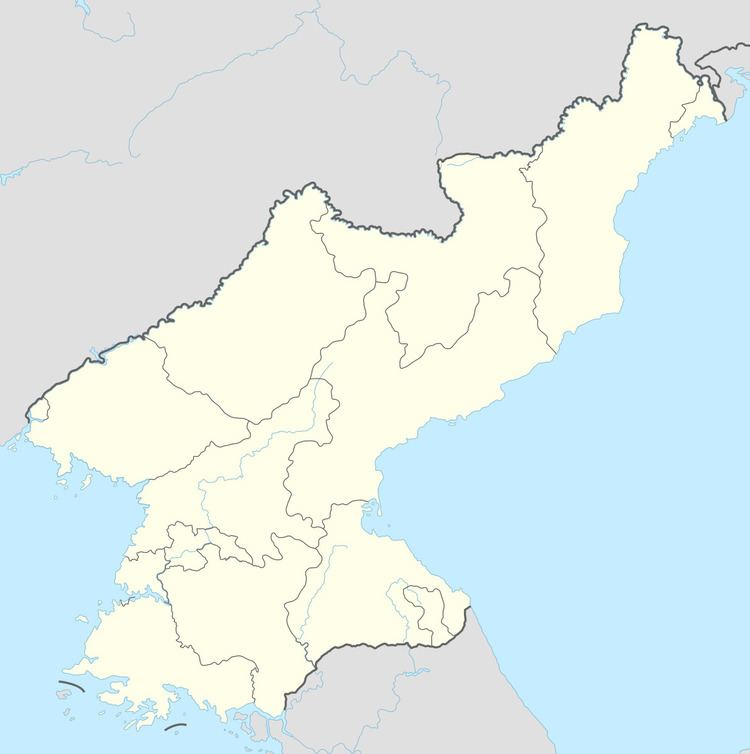Chosŏn'gŭl 관리소 Revised Romanization gwalliso | Hancha 管理所 McCune–Reischauer kwalliso | |
 | ||
North Korea's political penal labour colonies, transliterated kwalliso or kwan-li-so, constitute one of three forms of political imprisonment in the country, the other two being what Hawk (2012) which is translated as "short-term detention/forced-labor centers" and "long-term prison labor camps" for misdemeanour and felony offences respectively. In total, there are an estimated 80,000 to 120,000 political prisoners.
Contents
- Population
- Camp locations
- Camp closures
- Legislative structure
- Operating principles
- Working conditions
- Internment of prisoners
- Encampment outlay
- Zoning of prison camps
- Awareness
- Demand for closure
- References
In contrast to these other systems, the condemned are sent there without any form of judicial process as are their immediate three generations of family members in a form of sippenhaft. Durations of imprisonment are variable, however, many are condemned to labour for life. Forced labour duties within kwalliso typically include forced labour in mines (known examples including coal, gold and iron ore), tree felling, timber cutting or agricultural duties. Furthermore, camps contain state run prison farms, furniture manufacturing etc.
Estimates suggest that at the start of 2007, a total of six kwalliso camps were operating within the country. Despite fourteen kwalliso camps originally operating within North Korea, these later merged or were closed following reallocation of prisoners.
Population
There are currently between 80,000 and 120,000 political prisoners in kwalliso. The number is down from 150,000–200,000 during the 1990s and early 2000s, due to releases and deaths. The earliest estimates were from 1982, when the number was thought to be 105,000.
Camp locations
North Korea's kwalliso consist of a series of sprawling encampments measuring kilometers long and kilometers wide. The number of these encampments has varied over time. They are located, mostly, in the valleys between high mountains, mostly, in the northern provinces of North Korea. There are between 5,000 and 50,000 prisoners per kwalliso.
The kwalliso are usually surrounded at their outer perimeters by barbed-wire fences punctuated with guard towers and patrolled by heavily armed guards. The encampments include self-contained, closed "village" compounds for single persons, usually the alleged wrongdoers, and other closed, fenced-in "villages" for the extended families of the wrongdoers.
The following lists the operating kwalliso camps:
Camp closures
Notable kwalliso closures are listed below:
Legislative structure
The kwalliso are run by a secret police agency and are therefore not specifically tied to the laws and courts of the North Korean government. However, each camp is expected to operate in strict accordance with state Juche ideology.
Operating principles
Detainees are regularly told that they are traitors to the nation who have betrayed their Leader and thus deserve execution, but whom the Workers' Party has decided, in its mercy, not to kill, but to keep alive in order to repay the nation for their treachery, through forced labour for the rest of their lives. The emphasis of these camps is very much placed upon collective responsibility where individuals ultimately take responsibility for their own class' "wrong doing". Kwalliso guards emphasize this point by reportedly carving excerpts from Kim Il-sung's speeches into wood signs and door entrances. Work teams are given stringent work quotas, and the failure to meet them means even further reduced food rations.
Working conditions
Below-subsistence level food rations coupled with hard, forced labour results in a high level of deaths in detention not only as a result of working to death but also by rife disease caused by poor hygiene conditions. Corn rations are the usual staple diet of any prisoner but these may be supplemented by other foods found during labour such as weeds and animals. Each five-person work group has an informant, as does every prison camp "village". Survivors and commentators have compared the conditions of these camps to those operated in Central and Eastern Europe by Nazi Germany during World War II in the Holocaust calling the DPRK's network of political prison camps the North Korean Holocaust. There have also been comparisons between the North Korean network of political prison camps to the penal labor colonies of the USSR under Joseph Stalin, with many Western media outlets describing "Kwalliso" as "North Korea's Gulag"
Internment of prisoners
Defector statements suggest prisoners come to the camps in two ways:
Encampment outlay
Guard towers and barbed wire fences usually demark camp boundaries apart from where terrain is impassable. Prisoners are housed within scattered villages usually at the base of valleys and mountains. Single inhabitants are sub grouped accordingly into an assigned communal cafeterias and dormitories and families are usually placed into shack rooms and are required to feed themselves.
Zoning of prison camps
Areas of the encampments are zoned or designated accordingly for individuals or families of the wrong-doers or wrong-thinkers. Both individuals and families are further sub divided accordingly into either a "revolutionary processing zone" or "total control zone":
Awareness
Statements taken from North Korean defectors suggest that despite the secretive nature of these labour camps, North Koreans are aware of a system (at the very least) of camps in existence and are known to refer to political prisoners as "people who are sent to the mountains".
Demand for closure
Amnesty International summarize the human rights situation North Korea's kwalliso camps: "Men, women and children in the camp face forced hard labour, inadequate food, beatings, totally inadequate medical care and unhygienic living conditions. Many fall ill while in prison, and a large number die in custody or soon after release." The organization demands the immediate closure of all other political prison camps in North Korea. The demand is supported by the International Coalition to Stop Crimes against Humanity in North Korea, a coalition of over 40 human rights organizations.
